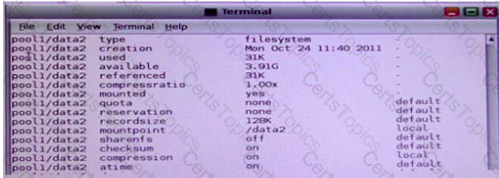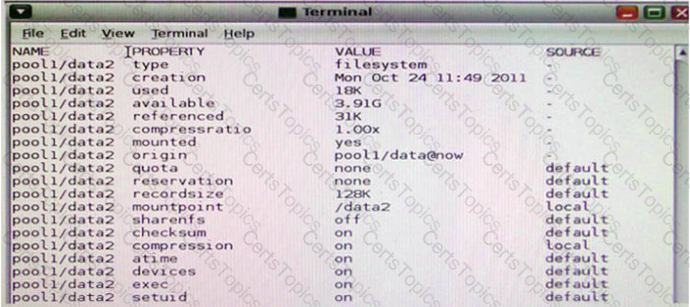Identify two correct statements about the Distribution Constructor. (Choose two.)
View the Exhibit, and review the zpool and ZFS configuration information from your system

The application development team requested an up-to-date copy of the data from the /prod_data file system. You decide to give the team one of the disk drives containing the data by breaking the mirror, removing the disk c4t1d0 and mounting c4t1 dO under a new mount point named /dev_data. Identify the correct procedure for breaking the mirror, removing c4t1d0. and making the data on that drive accessible under the /dev_data mount point
Which three statements accurately describe the Automated Installation (Al) client? (Choose three.)
View the Exhibit and review the file system configuration.

Identify the correct procedure to create a file system with the same properties as the file system displayed in the exhibit
You display the IP Interface information with ipmpstat - i
Which two characteristics are indicated by characters that may be included in the FLAGS column?
You are troubleshooting the failure of a computer to mount an NFS file system hosted by a server (hostname mars) in the local area network.
Select the three commands that will enable you to identify the problem.
You are using A! to install a new system. You have added the following information to the Al manifest:
configuration type-'zone" name-'dbzone" cfg/zonecfQ7 >
Which statement is true with regard to the zone.cfg file?
Before booting testzone. a non-global zone, you want to connect to the zone s console so that you can watch the boot process. Choose the command used to connect to testzone's console.
Select the two statements that correctly describe the operation of NWAM.
You execute the command:
usermod -K limitpnv=all,\!file_wnte guest
What is the result of this command?
Select the two correct descriptions of the configuration of a default installation of Oracle Solaris 11. (Choose two.)
You create a flash archive of the Solaris 10 global zone on the serves named sysA. The archive name is s10-system.flar, and it is stored on a remote server named backup_server.
On sysA, you create a Solaris 10 branded zone named s10-zone.
You want to use the flash archive, located On" /net/bactup_servers/10-system.flar, to install the Operating system in the s10-zone zone.
Which command do you choose to install the s10-system.flar archive in the Solaris 10 branded zone (s10-zone)?
You upgraded your server to Oracle Solaris 11 and you imported zpool (pool1) that was created in Solaris 10. You need to create an encrypted ZFS file system in pool1, but first you need to make sure that your server supports ZFS encryption.
Which four statements are true for support of ZFS encryption?
Which four statements describe the function of the svc://system/install/server;default service? (Choose four.)
When setting up Automated Installer (AI) clients, an interactive tool can be used to generate a custom system configuration profile. The profile will specify the time zone, data and time, user and root accounts, and name services used for an AI client installation. This interactive tool will prompt you to enter the client information and an SC profile (XML) will be created.
Which interactive tool can be used to generate this question configuration?
Identify the Automated Installer’s (AI) equivalent to jumpStart’s finish scripts and sysidcfg files.
View the exhibit to inspect the file system configuration on your server.

You department's backup policy is to perform a full backup to a remote system disk on Saturday.
On each weekday, you are to perform an incremental backup to the same remote system disk.
Each incremental backup will contain only data that has been modified since the previous Saturday backup.
The server file systems must remain available at all times and can never be taken offline.
The backup must not only provide for the recovery of the most recent version of a file, but must also allow recovery of previous versions of a file.
Following your company policy, which two describe the correct procedure to be performed on each weekday for backing up the /data file system to a remote disk named /remote/backup?
After installing the OS, you boot the system and notice that the syslogd daemon is not accepting messages from remote systems.
Which two options should you select to modify the syslogd daemon configuration so that it accepts syslog messages from remote systems? (Choose two.)